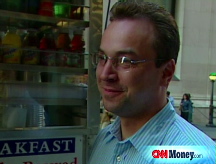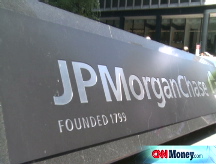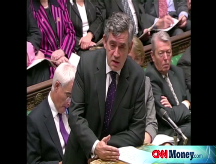Wall Street's 8 brutal days
Dow plunges 2,400 points, or 22%, as panicked investors run for the exits.

 |
| The Dow swung over 1000 points between its low and high Friday - the first time ever in its 112-year history. |
NEW YORK (CNNMoney.com) -- The Dow ended its worst week ever Friday and capped a staggering eight-session selloff that has seen the blue-chip index fall 2,400 points.
Investors could be in for another rough ride as Citigroup (C, Fortune 500) and Merrill Lynch (MER, Fortune 500) are on tap to report results this week, giving another glimpse into just how deep their losses continue to be. And a slew of economic reports are also due out, including readings on consumer spending and housing.
Much of the Dow's loss occurred over the most recent sessions as the global credit market crisis intensfied. In fact, last week the Dow fell just over 1,874 points, or 18%. The index has lost nearly 22% over the last eight sessions, as panicked investors ditched stocks across the board.
That panic also gripped the global markets, which have seen some brutal selloffs of their own.
"The magnitude of what's going on is unprecedented and people are frightened," said Robert Philips, senior portfolio strategist at BLB&B Advisors.
Finance ministers from the Group of Seven nations said Friday that exceptional steps were needed to ease the global financial crisis and get money flowing again.
And early Saturday, the G-7 vowed to work together to stem the criris. Later in the day, the International Monetary Fund soundly endorsed the G-7 commiment, with IMF managing director Dominique Strauss-Kahn saying the crisis "had pushed the global financial system to the brink of systemic meltdown."
Wall Street lost roughly $2.4 trillion in market value during the week, according to losses in the Dow Jones Wilshire 5000, the broadest measure of the market.
And investor fear surged to record levels, with the CBOE Volatility (VIX) index, or the VIX, hitting a record just shy of 77 Friday, before closing a bit off those levels.
The Dow Jones industrial average (INDU) ended Friday's session down just 128 points, after falling as much as 697 points in the morning. The Standard & Poor's 500 (SPX) index also declined Friday and for eight sessions in a row. The Nasdaq composite (COMP) ended barely higher, following seven down sessions.
Paralyzing fear. Banks have clamped down on capital, with credit markets remaining frozen and several measures of bank nervousness hitting all-time highs. Treasury prices slumped, boosting the corresponding yields as investors no longer bet that government debt was necessarily so much safer than stocks. The dollar recovered versus other major currencies. And oil, gold and other commodities plunged on bets that slowing global demand will hurt oil usage.
"Investors are the most fearful they've ever been," said Phil Orlando, chief equity market strategist at Federated Investors.
The heightened volatility that has left investors seasick was evident in Friday's market. In the first five minutes of trade Friday the Dow plunged 697 points, falling below 7,900 to the lowest point since March 17, 2003. The Nasdaq and S&P also hit more than five-year lows. But stocks recovered abruptly, with the Dow erasing losses. The afternoon saw the Dow make violent swings back and forth, toppling as much as 600 points and rising as much as 322 points.
Stocks have plunged despite a series of efforts on the part of the government to unfreeze the credit markets and get money flowing through the system again.
"Fear is feeding upon itself and nothing the officials have done to this point seems to stem the tide," said Ryan Atkinson, market analyst at Balestra Capital.
Last week, the Fed announced an emergency rate cut, coordinated with banks around the world. The central bank has also pumped billions into the system. But the moves have hardly made a dent in investor sentiment.
"Central banks of the world have been flooding the markets with liquidity, but banks are hoarding cash," Atkinson said. "This is the lynchpin of the entire financial system and as long as this is still going on, the markets will be driven by fear."
On Friday, President Bush said that the government will continue to work to resolve the economic crisis to return stability to the markets. Meanwhile, House Democrats are meeting Monday to discuss a potential second economic stimulus package, although House Republicans are reportedly skeptical of a second package, CNN reports.
Looking for a bottom: Stocks have been in a bear market for most of the year, but the selling began accelerating in September following a series of bank failures and mergers.
Since hitting all-time highs a year ago, the Dow has lost just over 40% and the S&P 500 has lost 43%. The Nasdaq has not come close to reclaiming its tech-bubble record, but it did hit multi-year highs last October. Since then, the Nasdaq has fallen just over 42%.
And investors across the board are pulling money out of equities, with $43.3 billion pulled out of stock mutual funds during the week ended Oct. 8, according to TrimTabs Research.
"To some extent, we are seeing a retail investor capitulation," said Kelli Hill, portfolio manager at Ashfield Capital Partners. "And when everyone is getting out, that suggests we're getting closer to finding a bottom," she said.
Wall Street was last in a bear market between 2000 and 2002 amid the end of the tech bubble, a recession and the terrorist attacks on 9/11. But stocks bottomed in October 2002 and then again in March 2003, leading to a more than four-year bull market.
On Friday, the three major stock gauges fell to within shouting distance of that March 2003 bottom. Some market pros are wondering if that 2003 level could turn out to be the bottom for the 2008 bear market also. (Full story)
However, bottoms are often "retested," meaning stocks fall to a low, bounce for a few days or even months, then fall back to right around that low, before making a bigger, more sustained advance off the low.
That's what happened in the last bear market. Stocks bottomed in early October 2002, bounced a little bit in the lead up to the start of the Iraq war and then retested those lows in March of 2003 before moving higher.
Either way, the analysts spoken with agree that when the market does finally put a bottom in place, it will lead to an extensive rally.
One comfort for investors is the knowledge that there are limits to how low the Dow can go, thanks to rules put in place in the aftermath of the crash of Oct. 19, 1987, when the Dow plunged 22.6%. The NYSE has rules to halt trading if the Dow loses 10%, 20% or 30% in a single day. Trading is halted for 30 minutes, an hour or two hours, depending on the time of day. Trading is over for the day if the Dow loses 30%.
The Dow's 22% decline roughly compares with the two-day slide in the crash of 1929. On Oct. 28, 1929, the Dow fell 12.8% and it It fell an additional 11.7% the next day, according to Stock Trader's Almanac.
Bear vs. Bull: Looking for a bottom
Credit markets frozen: Amid the ongoing crisis, lending has dried up, making it difficult for businesses to function on a daily basis and for consumers to get loans.
The TED spread, the difference between what banks pay to borrow from each other for three months and what the Treasury pays, spiked to an all-time high of 4.65% Friday before pulling back slightly.
The wider the spread, the more reluctant banks are to lend to each other, rather than from the federal government. When markets are fairly calm, banks charge each other premiums that are not much higher than the U.S. government.
Three-month Libor, or what banks charge each other to borrow for three months, rose to a 2008 high of 4.82% Friday.
The yield on the 3-month Treasury bill, seen by many as the safest place to put money in the short term, fell to 0.24% from 0.5% Thursday, with panicked investors willing to take a piddling return on their money rather than risk stocks. Last month, the yield on the 3-month bill skidded to a 68-year low around 0%.
But in a sign that banks were willing to take a chance on near-term lending, Libor, the overnight bank lending rate, eased to 2.47% Friday from 5.09% Thursday, according to Bloomberg.com. Libor was at 2.15% a month ago.
Treasury prices slipped at the end of the week, raising the yields. The benchmark 10-year note ended Friday's shortened session at 3.88%. Treasury bond markets closed early Friday and are closed Monday for Columbus Day.
Other markets: Oil prices plunged $8.89 a barrel Friday, the second biggest decline ever, to settle at $77.70 a barrel on the New York Mercantile Exchange, a 13-month low.
Oil prices have tumbled on bets of slowing demand since the price of crude hit an all-time high of $147.27 a barrel on July 11.
Worried about your retirement? Tell us your story ![]()




